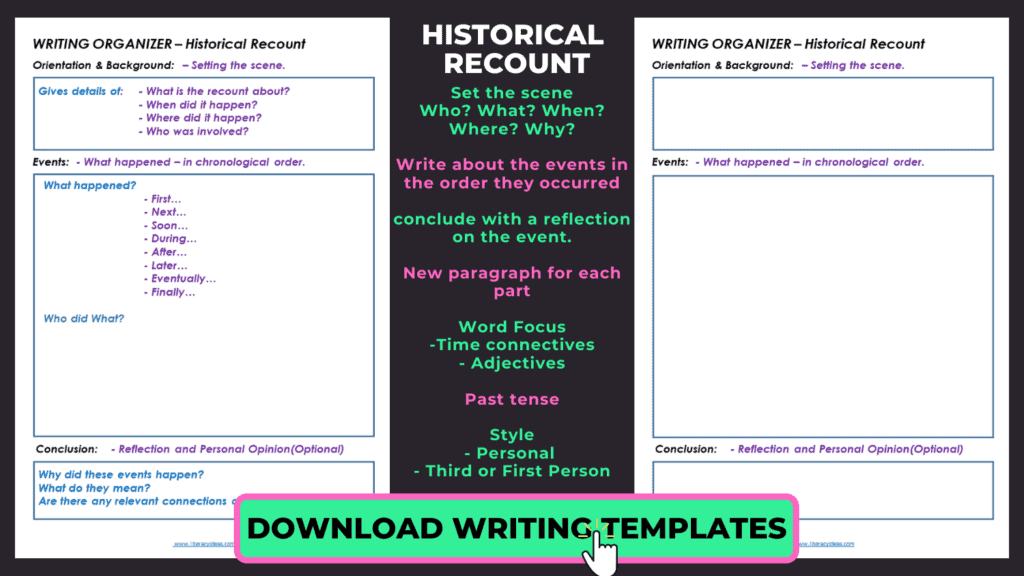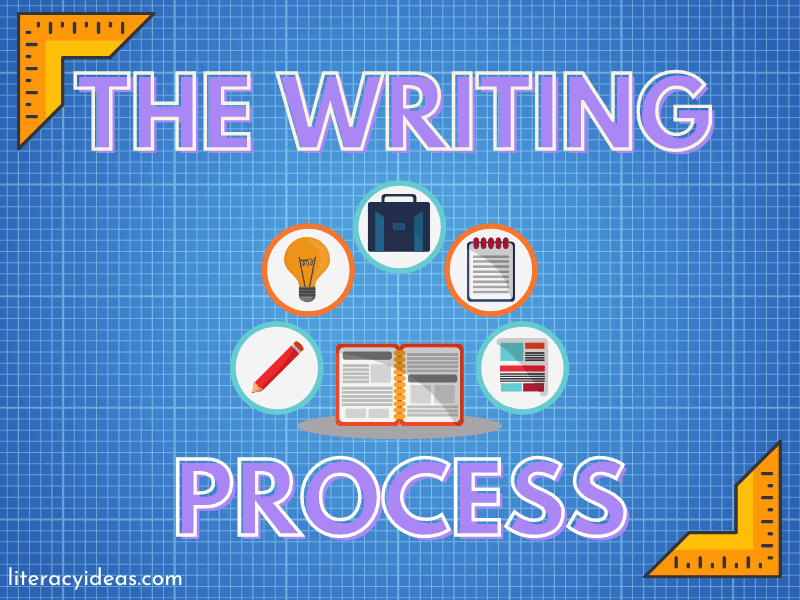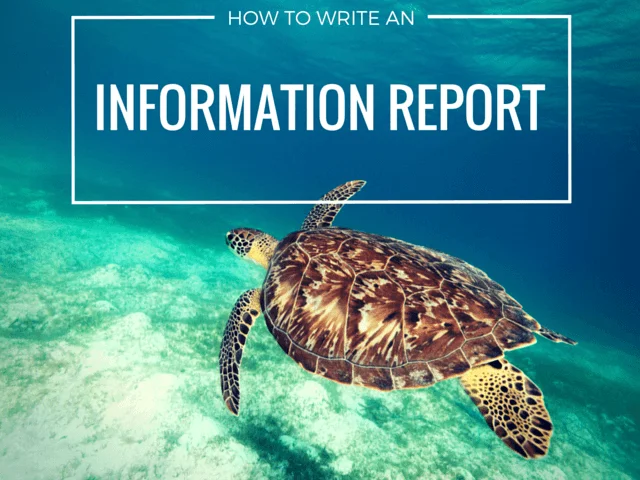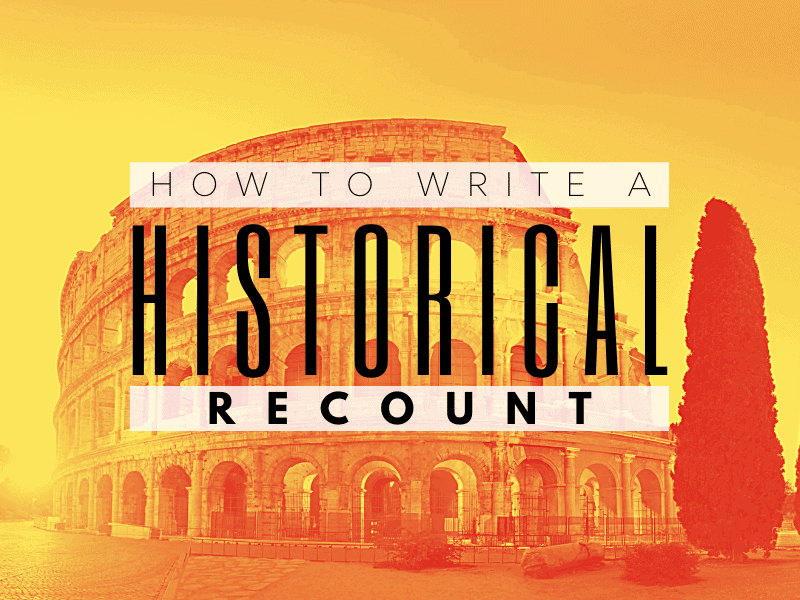
WHAT IS A HISTORICAL RECOUNT TEXT?
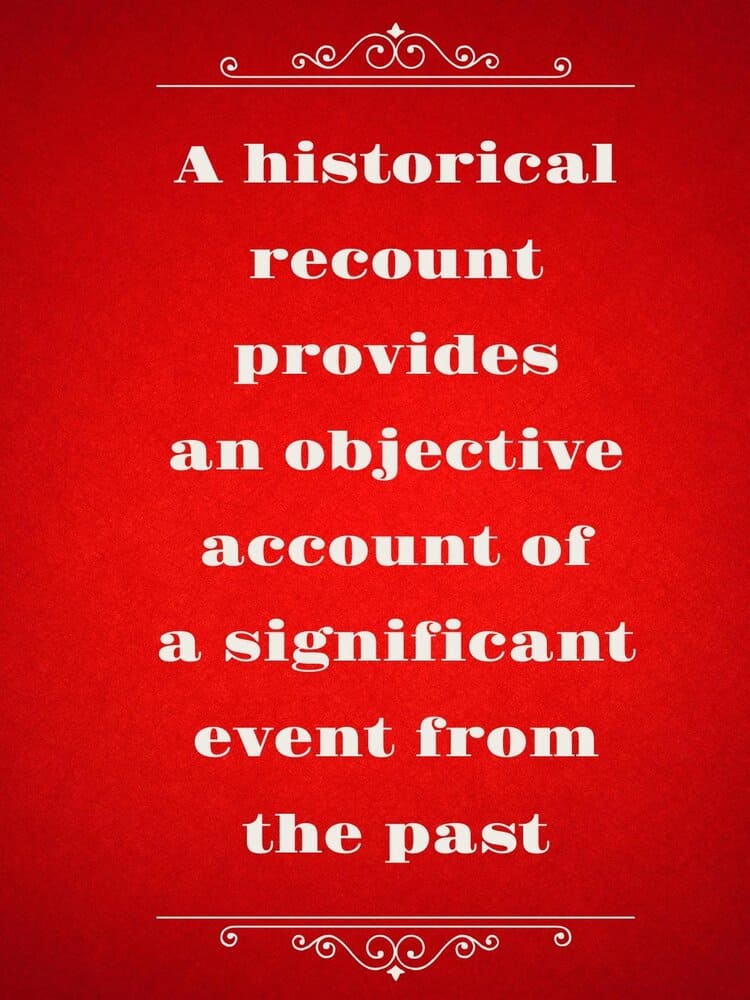
The purpose of a historical recount is to provide an objective account of a significant event that happened in the past.
As the writer, in this case, the student was not a witness to the events they are writing about, they will reconstruct the event’s details by using various primary and secondary sources.
While this type of recount has significant structural similarities with other types of recounts, such as personal recounts, literary recounts, and imaginative recounts, historical recounts also have some specific features all of their own.
Incidentally, if you want to find out more about other types of recounts, you can check out our information-packed article on the subject here.
Writing historical recounts is an excellent way for students to reinforce their understanding of this critical text type. They also provide an opportunity to review the chronology of an event and reflect on its importance.
A COMPLETE UNIT ON TEACHING RECOUNT WRITING
MASTER RECOUNT WRITING with this complete EDITABLE UNIT that ensures your students learn how to retell events with accuracy and energy. covering PERSONAL, FACTUAL, LITERARY and HISTORICAL RECOUNTS.
Teach your students to write AMAZING RECOUNTS in various styles with this COMPLETE 78 PAGE UNIT. No preparation is required.
Some possible topics for a historical recount text may include:
- A war or battle
- The reign of a ruler
- A revolution
- The development of an invention
At a higher level, historical recounts don’t just relate events in chronological order. Still, they also offer an opportunity for the writer to express their understanding of the significance of these events in a broader historical context.
With its primary focus on providing a factual, objective retelling of significant events, the purpose of this type of recount is more to inform than to entertain.
HISTORICAL RECOUNT TEXT STRUCTURE
ORIENTATION Introduce the who, what, when, where, how and why if possible in a historical recount.
RELEVANCE Be sure to focus on significant and relevant content to your historical event.
CHRONOLOGY Always explain events in the order they occurred.
VISUALS Be sure to uses images, maps and visuals if they support your text.
HINDSIGHT In a historical recount, you have the luxury of identifying what went right and wrong after an event. Be sure to explain the how and why to your audience to ensure they have a rounded understanding of your historical recount.
HISTORICAL RECOUNT TEXT FEATURES
PROPER NOUNS Use these to reference people, places and time events.
PAST TENSE Obviously, the event has passed. Be sure your audience read your historical recount in the past tense.
THIRD-PERSON PERSPECTIVE Whilst you can write a historical recount in the first person in most commonly they are written from a third-person perspective.
QUOTES Quotes and reported speech may add credibility to your historical recount.
HOW DO YOU WRITE A HISTORICAL RECOUNT?
When teaching our students to write any text type, we need to teach them a repeatable process they can turn to whenever they are asked to write a text of that type.
Text types are best understood as comprising two distinct elements:
- The Structure
- The Features
Let’s look at both of these in relation to historical recounts.
WHAT ARE THE THREE MAIN PARTS OF A RECOUNT?
The structure of a recount, historical or otherwise, can be divided into three main sections. These sections correspond broadly to the hamburger or 5-paragraph essay format – you can learn more about this essay structure here.
Now, let’s look at these sections of a historical recount in turn.
SECTION 1: ORIENTATION AND BACKGROUND
This first section focuses on introducing the topic of the recount to the reader and providing them with any necessary background information and context.
It can be helpful for our students to think of this opening section of their recount as answering a few essential questions:
- What event is the recount about?
- When did it happen?
- Where did it happen?
- Who was involved?
If the hamburger essay format is being adhered to, the answers to these three central questions will form the basis of the recount’s opening paragraph.
However, as with any section of the hamburger essay structure, students can add additional paragraphs to any of the three sections according to the complexity of the topic or level of detail the student wants to go into.
SECTION 2: THE SERIES OF EVENTS

After the orientation and background have been provided to the reader in the opening section, the second section of a historical recount will focus on relating the series of events.
The events will be related in chronological order, providing a clear structure for the student to follow as they progress through the body paragraphs of their text.
Here, the student will need to determine the level of detail they will go into. Usually, this will be set to a large degree either by an assigned word count or by focusing on the amount of detail required to answer the writing prompt satisfactorily.
It can be helpful for students to think of this part of their recount as answering the fundamental questions:
- What happened?
- Who did what?
SECTION 3: THE CONCLUSION
While this section may be brief and rudimentary for younger students, it will provide a test of their higher-level thinking and writing skills for older students.
This section also provides an opportunity for the student writer to reflect on the wider historical significance of the events they have retold earlier in the recount.
Students can think of the conclusion to their historical recount as answering questions such as:
- Why did these events happen?
- What do they mean?
- Will reference to other historical or present-day events add greater context?
Practical Tip #1
To help students internalize the structure above, create a simple graphical organizer using the headings of the three sections above.
Students can then use this organizer to plan their historical recount. This will help them stick to the structure in their writing and remember it the next time they come to write a recount.
The Features of a Historical Recount TEXT
With a solid structure to hang their texts on, students will now need to familiarize themselves with the features specific to this distinctive text type.
Let’s take a look!
Tone
A formal tone is the default setting for historical recounts. As the purpose is primarily to inform the reader in an objective manner, the content of this text type is most effectively delivered in a no-nonsense, formal style.
Passive Voice
While the active voice is also used in recounts, the passive voice helps create a sense of objectivity and keeps the focus on the deed rather than the doer of the deed.
Point of View
While some types of recounts, e.g. personal recounts, are suited to be written from a first-person perspective, the historical recount is generally written from a third-person point of view.
This POV provides distance from the events allowing for greater objectivity and impartiality, both of which are hallmarks of the first two sections of this type of recount.

Tense
In common with other recount types, the historical recount is written almost exclusively in the past tense as the events have already happened.
However, exceptions to this ‘rule’ can be found in direct quotations and the conclusion section, where the reader may relate the events or their impact to the present day.
Connectives
As mentioned in the structure section, the events in a recount are related in chronological order. Time connectives can help facilitate this. For example:
- First
- Next
- Then
- Finally
As well as showing the order of events, connectives can also reveal the relationship between events. For example:
- As a result of
- Therefore
- Despite this
- As a consequence
Descriptive Detail
The writer must describe events in sufficient detail for the reader to understand what happened. Vagueness is the enemy of precise communication.
Practical Tip #2
Instruct your students to develop a checklist of the features above. They can then use this to help during the writing process and check their work in the editing process.
The Research Phase
The historical recount retells the details of an event or events. Students reconstruct these events from the details of their own research.
This research will be drawn from a variety of primary and secondary sources.
It is essential then that our students can:
i. Distinguish between primary and secondary sources
ii. Develop solid research skills.
i. Primary vs Secondary Sources
Primary Sources
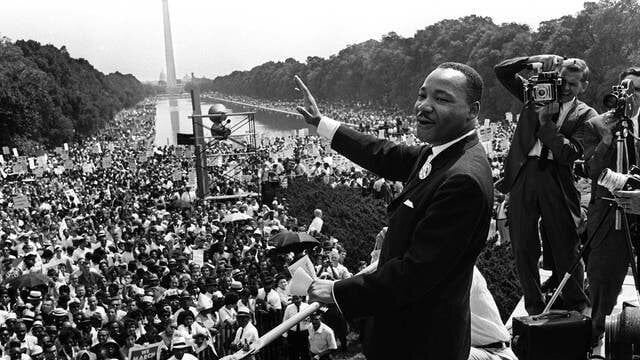
A primary source is a source of information that was created at the time the student is writing about.
Some advantages of primary sources include:
- Provides a first-hand account of the events
- Offers specific details from a single source
- Draws from a single, original source
- Is unfiltered
- Reflects the mood and context of the time
Some examples of primary sources include:
- Contemporary newspaper reports, magazine clippings, books
- Photographs
- Video, film, and audio recordings
- Letters, diaries, journals, scrapbooks
- Police reports, eyewitness accounts, government publications, etc.
COMPLETE TEACHING UNIT ON INTERNET RESEARCH SKILLS USING GOOGLE SEARCH
Teach your students ESSENTIAL SKILLS OF THE INFORMATION ERA to become expert DIGITAL RESEARCHERS.
⭐How to correctly ask questions to search engines on all devices.
⭐ How to filter and refine your results to find exactly what you want every time.
⭐ Essential Research and critical thinking skills for students.
⭐ Plagiarism, Citing and acknowledging other people’s work.
⭐ How to query, synthesize and record your findings logically.
Secondary Sources
A secondary source is a source of information that was created after the event by someone who did not experience the event/s.
Some advantages of secondary sources include:
- Provides a perspective on an event offered by time
- Gives a wider overview of the event
- Weaves multiple perspectives together
- Places an event in a wider historical context
- Assesses the historical accuracy of multiple sources
Some examples of secondary sources include:
- Textbooks
- Encyclopaedias
- Reviews
- Biographies
- Reviews
Practical Tip #3
To help students gain some experience recognizing the difference between primary and secondary sources, gather together lots of samples of sources such as those listed above. Get students to sort the various sources into two groups: primary and secondary.
Note too; some information sources may combine elements of primary and secondary sources.
For example, a documentary film may make use of archival film footage from the time (a primary source) while also utilizing commentary from contemporary historians (a secondary source). Discuss this with the students when they have completed their sorting activity.
Research Skills
Given the nature of historical recounts, it should be no surprise that research skills play such an essential role in their composition.
Developing excellent research skills takes a lot of time and hard work, and the topic is much too broad to be covered comprehensively within the limits of this article. But, if you want more information on the most effective research strategies to help your students, check out this article right here.
Undoubtedly one of the most important study skills our students can develop is, note-taking, when we extract information from a source and record it in an abbreviated way to use later during the writing process.
The development of good note-taking skills will help our students extract information from everything from books, lectures, and presentations to articles, documentary films, and photographs.
As with most skills, note-taking is improved through practice. But, luckily, there are certain Do’s and Don’ts that can be learned quickly to help.
Check out the table below for the main Do’s and Don’ts of Note-Taking.
THE DO’S AND DON’TS OF NOTE-TAKING
DO THESE
DO JOT DOWN MAIN IDEAS Keywords, definitions, and examples
DO USE HEADINGS For different sections
DO PARAPHRASE To strengthen understanding and help with recall.
DO HANDWRITE But make sure notes are legible
DON’T DO THESE
DON’T WRITE EVERYTHING DOWN Stick to what is relevant and engaging.
DON’T WRITE IN LARGE BLOCKS OF TEXT Break your ideas into smaller chunks.
DON’T COPY WORD FOR WORD Use your own voice and ideas.
DON’T TYPE When taking notes, grab a pen instead.
Practical Tip #4
Note-taking is a specific skill that takes time to develop but will reap huge rewards for students throughout their academic careers. Unfortunately, however, it isn’t frequently taught as a specific skill. The truth is, most of us take notes inefficiently.
It is certainly worth the time required to teach your students good note-taking practices, and writing a historical recount provides a perfect opportunity to reinforce these best practices.
An excellent activity to facilitate this practice is to provide your students with an extract to take notes on while adhering to the do’s and don’ts in the table above.
When students have finished, have them compare their notes with their classmates. Encourage discussion and comparison. This will provide feedback for students that will help them perfect their process.
The following questions can help stimulate that discussion:
- What were the similarities and differences between the different notes taken?
- What information was included in the notes that could have been left out?
- What was missing?
- What did the student do well in their note-taking?
- What could they do to improve the next time?
Teaching Resources
Use our resources and tools to improve your student’s writing skills through proven teaching strategies.
HISTORICAL RECOUNT TEXT GRAPHIC ORGANIZER (USE SLIDER)
A HISTORICAL RECOUNT TEXT EXAMPLE
Below, you will find an annotated historical recount example, use this as a reference with your students.

To Conclude
We’ve covered quite a lot of ground in our exploration of the historical recount. No doubt, it will take time and practice for our students to master all these elements and bring them successfully together in a cohesive whole in the form of a well-written historical recount.
That said, by following the process and the activities outlined above, your students will soon be producing structurally sound and coherent recounts.
RECOUNT WRITING CHECKLIST & RUBRIC BUNDLE
⭐⭐⭐⭐⭐ (92 Reviews)






